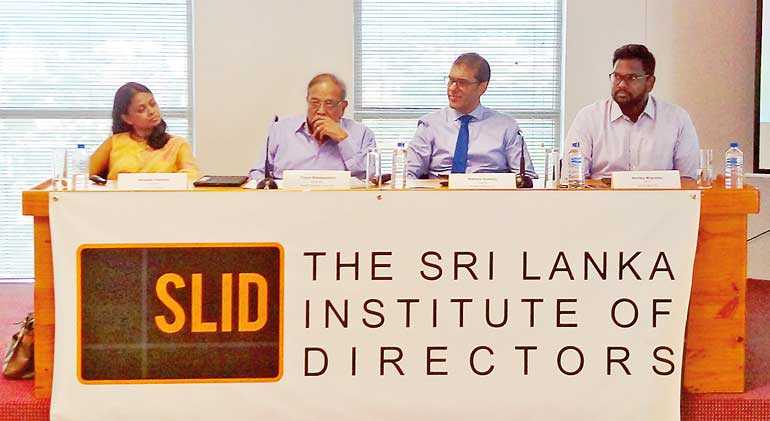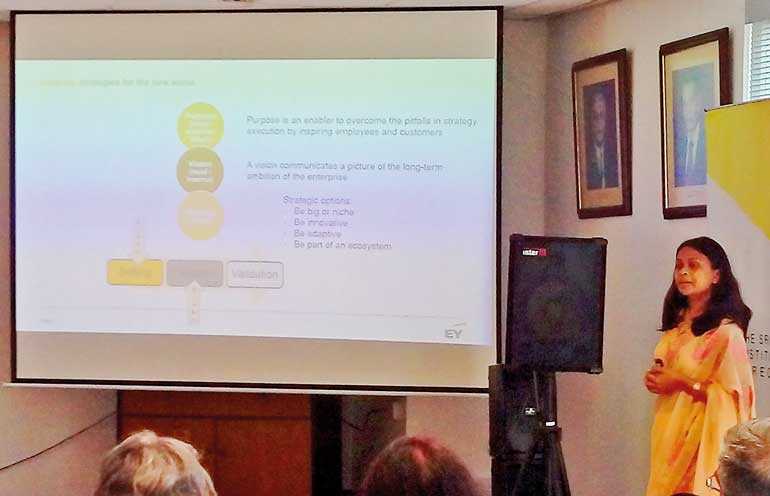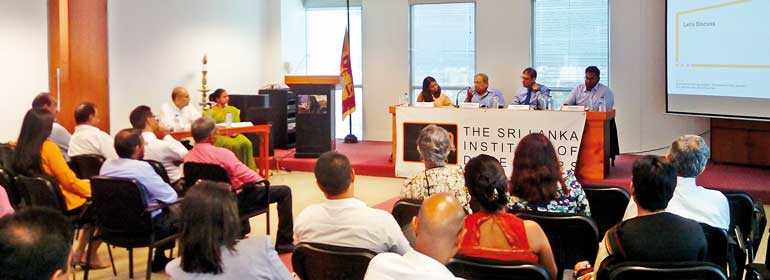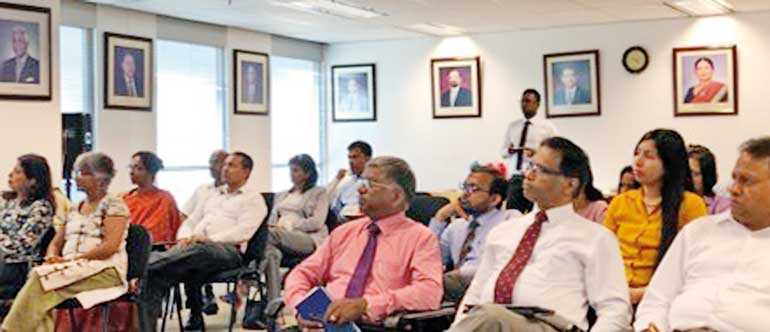Tuesday Dec 16, 2025
Tuesday Dec 16, 2025
Thursday, 12 September 2019 00:00 - - {{hitsCtrl.values.hits}}


The role of the independent non-executive director in the strategy conversation in the boardroom featured as the discussion topic at a recent session of the Sri Lanka Institute of Directors (SLID) Independent Directors (INED) Forum held at the Securities and Exchange Commission (SEC) Auditorium.
The session was chaired by Faizal Salieh, Forum Chairman and SLID’s Senior Vice Chairman, with Vijaya Malalasekera, Chairman, Bogala Graphite Lanka PLC, Murtaza Esufally, Director, Hemas Holdings PLC and Anushka Wijesinha, Independent Non-Executive Director, Seylan Bank PLC as the panelists, and Hiranthi Fonseka, Partner, Ernst and Young as the keynote presenter who set the tone for the discussion.
How does the board oversee strategy, and what is the role of an Independent Non-Executive Director (INED) in that process? The topic begs the question, who is responsible for strategy? Most governance frameworks pin the responsibility of strategy on the Chief Executive Officer (CEO). The board of the organisation must approve the strategy and oversee the execution of such strategy, albeit with timely improvements to keep the strategy live and credible.
In her keynote presentation, Hiranthi Fonseka shared the critical challenges that independent directors may face in contributing creatively and constructively to oversee the strategy of a corporate.
Time
Time is one of the biggest obstacles for an INED in the board’s oversight role. A board may typically meet six to eight times a year, with an agenda that is packed with on-going business battles, compliance issues and financial reporting matters. This leaves little time for deliberation on strategy, its execution, and more importantly, its validity.
Does the information provided enable contribution?
Another decisive factor of efficient and effective contribution by an INED to strategy is whether information for evaluation is put forth in a manner that enables such contribution. For example, if the board spends half the time allocated for oversight of strategy on deliberating on the credibility of information, or understanding the information presented, the task of overseeing becomes even challenging.

Board composition
The board’s composition also has a significant impact on the oversight of strategy. Whilst the CEO and executive directors will be much involved in the execution of the strategy, the INED’s contribution is of paramount importance as it brings independence, fresh thinking, and the right amount of scepticism into the discussion of strategy and its execution in the boardroom. The inputs from INEDs would distinctly help enrich the strategy discussion and periodic reviews of strategy execution at the board level. For such a process to be effective, the INEDs on the board must have the right mindsets, be prepared to ask pertinent questions and challenge the strategy propositions put forward by the executive management of the company.
The UK Corporate Governance Code states that the role of non-executive directors is to constructively challenge and help develop proposals on strategy. This may mean that INEDs are required to both challenge the company executives and hold them to account whilst contributing their respective skills and experience to set the strategic direction. Depending on the complexity of the organisation, the board may also need to consider creating a dedicated board sub-committee on strategy, sometimes called a strategic planning committee or strategy review committee. It is a common practice for companies to have the senior executive management headed by the CEO to execute the strategy. However, we have seen the dangers of complacency that has resulted in the downfall of many corporates worldwide. Therefore, strategy needs to be reviewed and invigorated in a timely manner for a company to succeed. This is where the INEDs can provide fresh thinking in an independent manner for the long-term sustainability of the company.
She posed the following questions for further discussion. Is the strategy of the company being explicitly considered in a timely manner? Are the INEDs’ contribution sufficient? Is there a balance between remuneration and independence? What is the oversight role of the board? Do we need a board sub-committee to oversee strategy? How frequently should the strategy topic be taken up and, how frequently should it be revisited? Does the board have the right skills (composition) and if not, how does the board acquire such skills? Is the board enabled with complete information to do justice? In identifying potential candidates for INEDs, is adequate consideration given on their ability to contribute to strategy?
Strategy
The panellists shared their own experiences and views on the subject. Vijaya Malalasekera, a senior corporate director, commented: “Strategy is to basically understand where you are going.”
He further said: “The company’s strategy can be developed by management but must be signed off by the board. The board needs to have a clear input into the strategy. The directors should take into consideration the environment in which the company operates, the goals of the company and its plans to achieve it. When an INED is selected in a well governed company, the nominations committee has to identify the strengths that are required to mitigate the weaknesses in the board and then look for a candidate who can work in a team to fill that gap. It is difficult to say that one cap fits every company. It depends on the industry that the company operates in. The board’s ultimate responsibility is to sign-off on strategy. Have a discussion prior to this and if you don’t agree don’t sign-off.”
Malalasekera stated that in the boards t hat he had served so far, there has not been a dedicated board level strategy committee but that even a management level committee comprising managerial executives and a couple of INEDs could work well.
Murtaza Esufally, drawing from his experience with his Group of Companies, shared that every year they have a formal review of strategy at a board retreat at an outside location in an open and free environment. He commented that the board’s role is an iterative process.
The CEO and management must present the strategy but the board gives their comments early on what challenges should be addressed in the strategy. The Chairman plays a key role and has informal chats with the INEDs before the strategy session and both the directors and the executives have a free flowing discussion. The Chairman also directs the CEO to address the identified challenges.
He stated that there has to be a good informal relationship with social contact between the INEDs and management so that they can provide constructive criticism and that management takes it in the right spirit. He sees value in INEDs in the strategy conversation. They should question whether the strategy is robust enough to handle all the challenges that it faces.
The biggest challenge that his company faces is that as their INEDs come only quarterly and there is a disconnect with the company strategy. As a solution, the INEDs meet the management, visit the factory, have marketing discussions etc a day prior to the board meeting. They don’t have a dedicated board level strategy committee but have a management level sub-committee which non-executive directors may attend.
Anushka Wijesinha was of the view that there is a concern that where there are challenging economic conditions and market conditions the INEDs have a role to play in seeing beyond the short term. It was good practice to have a dedicated agenda item or an opportunity that is built in or that the chairman provides at a board meeting to have the strategic thinking conversation regardless if you have a strategic plan or not.
He stated that at Seylan Bank the composition of the board level strategy committee largely comprises INEDs and it was proving to be useful as they have the ability look at the strategy of the business from multiple angles different to what the management would see. His take away was that, depending on the INED mix you have on the board, the richer would be the strategy conversation.
INEDs in the boardroom
Hiranthi made some points with regard to INEDs in the boardroom. An INED could be a contrarian and fresh thinker as distinctly different from the shareholding directors and the CEO; a sounding board, entreprenurial and a trusted source of advice and emphasised that if an INED could live and breathe these traits there can be value to the strategy conversation in the boardroom.
Do INEDs understand this? Do they strive to bring these characteristics to the boardroom? Do nomination committees look for these characteristics and look for the ability of the INED to bring this into the strategy conversation? A dedicated strategy committee is useful as there are many items on the board agenda that could impair the conversation focus on strategy.
In answer to the question on “How do you see the role of the INED in the strategy conversation?” the panel was in agreement that the nomination committee has a critical role in selecting the right people. They need to identify the talent gaps that exist at the board level and make sure that the required skills are brought into the board. For a strategy conversation if the verticals are not properly represented you are not going to get a proper view.

Skill and experience gaps
Responding to a question raised by Faizal Salieh, the Forum Chairman, whether there is documented evidence seen in the minutes of nominations committees about sufficient consideration being given to address the skill and experience gaps and the desired INED characteristics, Manil Jayasinghe, Partner EY, stated that as external auditors they do spend time looking at board and board committee minutes and in his experience he has observed that the minutes of nomination committees do not sufficiently capture the discussion but only record the conclusions.
In the case of banks, because of the Central Bank regulations, the critical essence of the discussion gets captured but yet the minutes do not indicate these aspects. Judging by what he has seen and heard, he is of the view that a lot of thought process does not go into it. It is about striking a balance – you can’t have only people who challenge or only people who say yes. If everyone starts challenging the board becomes dysfunctional. Getting this right balance is the most difficult part in constituting a board.
Sujeewa Rajapaksa, Partner, BDO Consultants, shared that when he attends a board meeting he takes the strategic plan document with him. In general, he has observed that the document is forgotten. He advised that INEDs should go prepared for meetings and read all the documents provided. “Do the right thing and don’t compromise yourself,” he said.
Murtaza Esufally stated that more than formulation of strategy, it was the execution of strategy that requires focus. In the Hemas Group, at the start of the meeting they review the execution of the strategy. He advised “you should not leave it to the management to present on the strategy milestones as sometimes this could be different to what was expected.”
Vijaya Malalasekera shared that at one company they would break the strategy document into parts and distribute it among the heads of each division and on a quarterly basis the performance of the division is monitored which helped the board to keep in touch with the strategy. This is usually done by the board audit committee and the chairman is invited to attend but not as a participant. The INEDs can then ask the question from management on what assistance they require from the board to achieve the milestones.
Anushka Wijesinha commented that the bias for action needs to be consistent. Not the board members trying to act but ensuring that the management acts and the business has a bias for action. In that process the execution, ability and reflection conversation comes about. In times of stress, any strategy that was formulated previously will have to change. Management will need to adjust the strategy. In this scenario the INED’s role is to give the support to management to check and adjust the strategy and to continue focusing on the long-term goals.
A living document
Salieh quipped that a company’s strategic plan should be a living document and not a shelf document, and it is the responsibility of the management to execute it. Most board tend to merely discuss the financial budget and the performance against the budget. It is the responsibility of the board to see if there are any execution gaps on the delivery of the strategy. Where the strategy review discussion features in the board agenda and the amount of time dedicated to the review is critical. Responsibility for that lie with the Chairman and the INEDs.
The discussants also noted that the company’s risk management process should assess all the business risks of the company and the role of INEDs is important in the board’s deliberations on the risk agenda at board meetings. There would be new risks that come up from time to time where the company’s strategic plan would need to be revised or changed.
The alignment of the company’s systems, processes and people to the strategy should be a matter for board focus in order to minimise the execution gaps. Misalignments result in failure in the execution of strategy. The forum discussed the usefulness of appointing an INED as the Chair of the board strategy committee and the risk management committee.
Handling conflicts
The panel also discussed how conflicts could be handled in the strategy conversation. Malalasekera noted that directors are generally reasonable and able to solve these matters through dialogue. “You must agree to disagree. If you disagree make sure that your dissent is recorded,” he said.
When there is a dedicated board strategy committee how much of conflict and tension should you be tolerated was also discussed. As INEDs less connected to the business as other directors, in particularly if INEDs are going to have views and opinions about strategy, INEDs need to take time to understand the business and not interfere with the business.
Staying “not too far and not too close” to the business activities becomes important. If a new strategy initiative is being launched, having a ‘strategy conversation workshop’, attending it as an observer to lend support to the management and also use it as an opportunity to have an informal chat with the executive team would go a long way.
The quality and honesty of the conversation around strategy would improve the relationship between the management and the board. INEDs have the right to information and should ask for it; the management and the board should ensure that the information flow is facilitated and good enough to enable INEDs to understand the business.
The forum noted that INEDs should be given a sound induction at entry level in order to expose them to the various issues facing the company and the industry, and the risks that the company has to deal with. Board director training and periodic refresher programs should be available to all directors. In order for the board to function well in getting things right for the company the board’s performance should also be regularly evaluated both at a collective and individual director level.